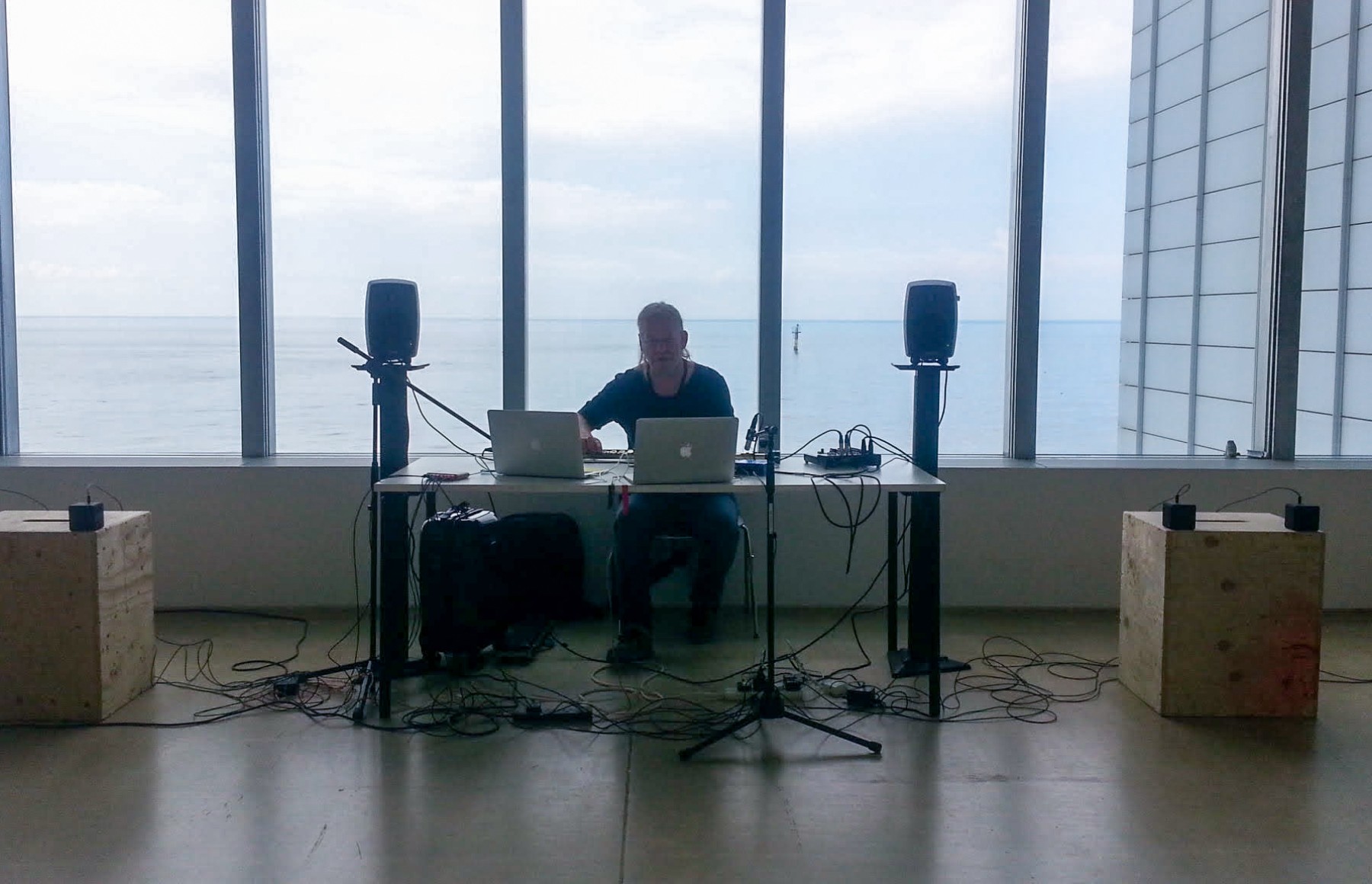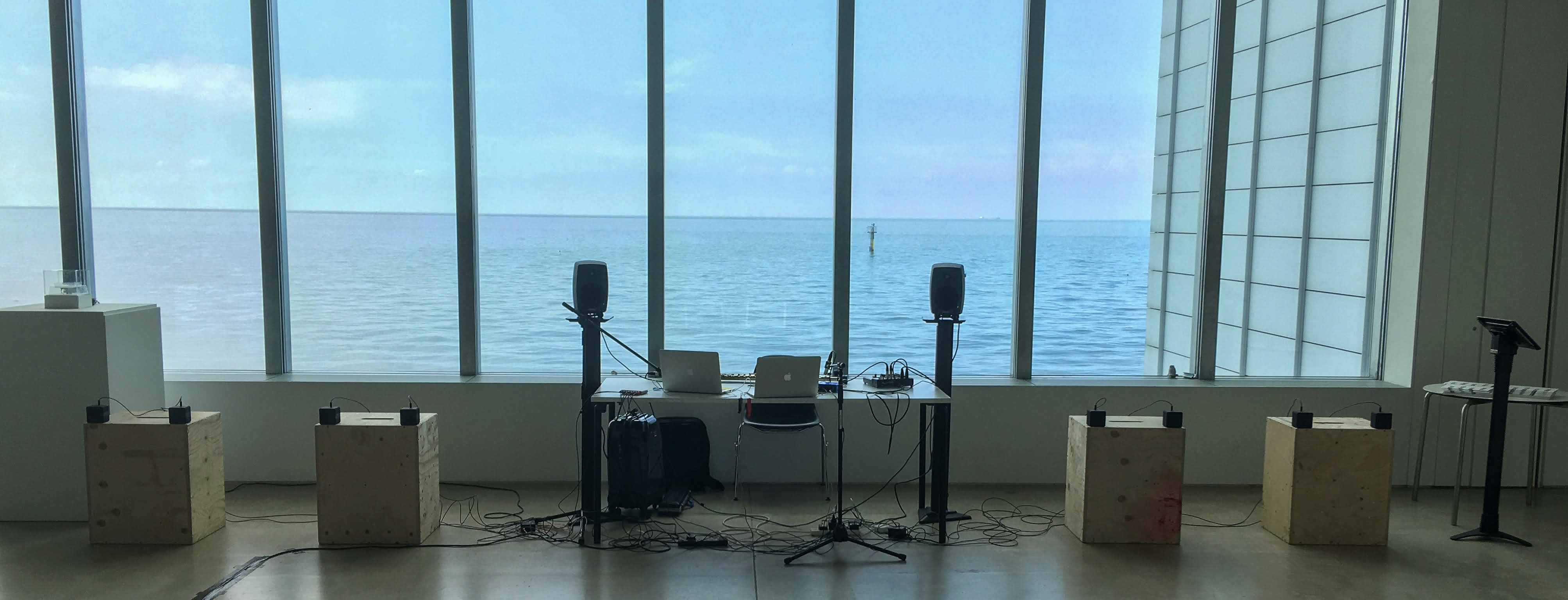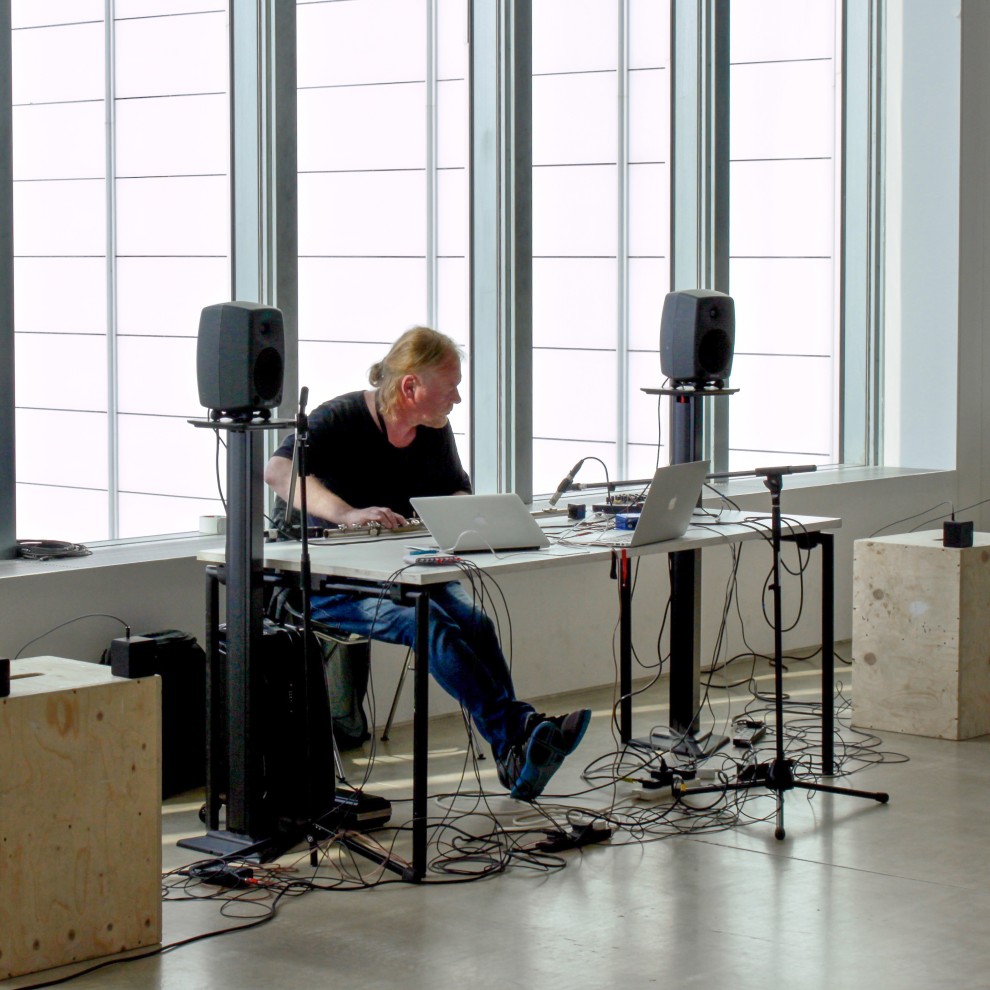
Introduction
Much of one’s work consists of trying to do things in a way one hasn’t done before – of trying to avoid the banality of one’s own practice. My previous installations – the 2016 ‘Longer to write than to speak; longer to think than to write’ and the 2006 ‘Proxemics: The world is a deaf machine’ have typically been responses to the work of other artists – here Irish poet Maria McManus and artist/sculptor Ian Tyson respectively. My composition and improvisation work in contrast tends to ‘self-generate’ from my own previous material. ‘Line’ collides elements from these two installations with the tattered, malfunctioning remains of my virtual/physical feedback flute project (2008) to see what results from a hybrid approach: performance-installation. It also celebrates ‘lineage’ in another sense, incorporating musical material not only from my own back-catalogue, but also by my co-researchers and performers Nic Collins and Jonathan Impett, which itself incorporates musical material from early 1600s Venice.
Description
Line distributes and localises different frequency zones to different areas - using a portable ‘diffusion system’. Most of the (relatively small, delicate) sounds are organised in a line of twelve small speakers across the space. Low frequency sounds are reproduced at a low amplitude only by the ‘house’ sound system (which should be very high quality, but at the lower threshold of audibility, as if moving air almost silently). A final stream of audio material is replayed through a loudspeaker system mounted in the head end of an alto flute, ‘activating’ it physically. The flute’s keys can be opened and closed, perceptibly altering the filtering and resonance of the replayed material, and the flute is thus ‘animated’ by the resonant frequencies of this material, ‘feeling’ alive to the performer. In the initial version of this piece the resulting flute sounds are picked up by 2 microphones and directed to a pair of small, high quality monitors within the space - contiguous with the initial line of speakers. It is intended that the idea of localising and physicalising sound in this precise way may aid its ‘comprehensibility’ and aid a sense of relational security for listeners.
Research
Line manifests a critique of ‘weak’ or ‘lazy’ conceptions of immersion, in which, typically, audiences are surrounded by loudspeakers to which sounds are directed in a manner designed to surprise and shock but without consideration of the essentially ‘facially-biased’ nature of human listening. As I have written in previous research (Waters 2007, 2013) much activity in technologised musicking proceeds as if space was a benign neutral category, in which the position, orientation, movement direction, and distance of sounds was a merely technological matter. Following Hall (1963) and others I prefer to regard music and sound as occupying proxemic zones (intimate, personal, local and environmental), each with different implications for perception and meaning-making. Likewise frontally-orientated sounds are construed very differently from otherwise ‘identical’ sounds from the rear. The latter, for humans lacking rearward visual correlation, tend to provoke an initial involuntary reaction of threat or anxiety. Current immersive sound technologies appear to be ignoring such environmental and cultural aspects of listening perception. Much acousmatic electroacoustic music for diffusion is presented in a similar manner.
By differentiating spatially on a deliberately ‘artificial’ axis - a line - which nevertheless has historical/architectonic comprehensibility and legibility, ‘Line’ is intended to provoke more critical modes of thought with regard to immersivity.
The work deploys spectral differentiation to establish a continuum between directionality and non-directionality which has its origin in human physiology and the acoustics of sound transfer through air in real spaces. The iterative and gently-sustained sounds are selected on the basis of their spectral characteristics to allow the trajectory or migration of sounds along the line of twelve loudspeakers to be tracked, much in the manner of acoustic music. These are optimised to sound plausible and ‘real’ through the small loudspeakers and are therefore characterised by mid-high frequency content. The only bass sounds occur sparsely, towards the end of the work, and are routed to the ‘house’ system or other bass-capable loudspeaker with no treble content, such that sonic direction is maximally ambiguised, and a clear distinction between the ‘linear’ sounds and a more ‘immersive’ bass world is established. The work recognises (and embodies) the specifics of a preconceived performer-instrument-environment model in which these apparent distinctions are deliberately refused and their interpenetrations emphasised, guiding the listening expectation. By acknowledging the historical embeddedness of ‘musical’ listening through a ‘work’ which transitions between material instantiated *wholly* in the now - in the immediacy of heard phenomena - and that instantiated in the now but referring explicitly to other historical and performative moments, the sense of ‘guided listening’ is enhanced. The work’s concerns with manifesting the impossibility of ‘individual’ making are addressed through the incorporation of (reference to) the work of my colleagues within the Music, Thought & Technology research cluster at the Orpheus Instituut, Ghent (Nicolas Collins and Jonathan Impett), although this is likely to be a more minor consideration for the majority of listeners..
Line is also concerned with scale - and in particular with the ‘non-scalability’ of amplitude in music. The piece is designed to be reproduced at a precise (subjective) level which takes into account the capacities of the replay system and the (physical) volume of the performance space. In general its reproduction is designed for a lower level than might usually be expected of ‘presented’ work, aspiring to ‘domestic’ or contemplative levels of audibility in spaces which might initially suggest more than this.
Line manifests a critique of current highly corporatised trends in immersive sound in a further sense; that of economics and sustainability. Almost the entire technical resources of the piece can be packed into a single suitcase, affording its re-instantiation in many acoustically and architecturally appropriate spaces (although in each case the exact nature of the work’s configuration is necessarily modified to optimise it for the precise environment).
Line was premiered at Turner Contemporary, Margate, in June 2018
Recorded documentation

Self-evidently a work designed to be listened to in particular conditions does not lend itself easily to reproduction in other contexts, but on 20 June 2019 a binaural recording was made of ‘Line’ in the controlled conditions of the Sonic Lab at the Sonic Arts Research Centre in Queen’s University Belfast. The recording, made using a Neumann dummy head, is available here. Please note that this binaural recording is made for relatively low level replay on headphones, not for reproduction on loudspeakers. It is in .flac format (lossless compressed format) as a compromise between file size and reproduction quality. Multi-channel ambisonic recordings were made at the same time, and these will be uploaded for comparison at a later date. I am grateful to Craig Jackson for engineering the recording session.

Trajectory of related research in previous works
‘Longer to write than to speak; longer to think than to write’
Simon Waters (2016)
A sound installation in response to the poem ‘Corncrakes’ by Maria McManus.
This ‘sound art’ piece presents two versions of Maria’s poem, one spoken by the poet, and one written (and overheard). The rest of the sound-world is intended to evoke the fragility and tenuous life of any organism as it adapts to the unforeseen-ness of its environment - an abstract reflection of the corncrake’s tenuous hold on life in a world which has moved on from haymaking. The sound work lasts around 17 minutes (followed by three minutes silence) and therefore plays approximately three times in each hour the gallery is open. In keeping with the title of the installation, the spoken version of the poem occupies only the first two and a half minutes of the work’s cycle. Other, more abstract sounds inhabit and populate the space of the installation, sometimes discrete and precise, sometimes ‘migrating’ across the space in more diffuse clouds, in a manner analogous to bird flocking (itself suggestive of the mass movement of human beings which characterises the beginning of the twenty-first century). The installation was designed for an art gallery context, where it accompanied responses to Maria’s poems by five visual artists, and was designed to be spread out over a seven metre long structure made up of twelve tiny loudspeakers, enhancing the capacity to read/comprehend the ‘migration’ of the various sounds involved (all of which are rather delicate, calculated to reproduce well on such small speakers, and replayed at relatively intimate levels).
‘Proxemics: The world is a deaf machine’
Simon Waters (2006)
This ‘active sound installation' was commissioned by the Sainsbury Centre for Visual Arts in 2006 and featured in a Channel 4 documentary on the sculptor/artist book-maker Ian Tyson. It was designed as a response to a major new Tyson work, ‘Proximity’, commissioned by Anne Dillman in commemoration of her husband, philosopher Ilhan Dillman, which at Tyson’s suggestion was placed outside the (Norman Foster) SCVA building to link it visually with the iconic ‘ziggurats’ (Denys Lasdun) which characterise the site of the University of East Anglia in Norwich. Waters’s work is therefore a response both to Tyson’s work, and to the architectural relationship between Foster and Lasdun. The work was commissioned for a vast indoor space in the SCVA within which Waters installed a circle of 8 extremely high quality studio monitors on plinths of four different heights, designed both to ‘modularise’ and accommodate differences in human height, and to refer to Lasdun’s stepped ziggurats. These presented a loop of material which was calculated to produce standing waves - with nodal points which could be experienced by moving within the space. In addition, each visitor was given an iPod and open-backed headphones, which presented individual listeners with a further subset of audio material calculated to interfere with and ‘complete’ the audio experience from the loudspeakers. The piece therefore presents a physically fixed sonic structure within which each visitor can individually ‘play’ the space, completing and actively discovering the interactions between local (headphone) and global (fixed loudspeaker) material, and the nodal points of the (invisible) standing waves in the space. They thus each have their own unique perspective on the structure - in much the manner in which Tyson’s 3D steel work affords and encourages multiple perspectives on ‘re-reading’ the relationship between Foster’s architecture and Lasdun's .
‘Travel fictions’
Simon Waters (1991)
‘Travel fictions’ consisted of a series of environmental recordings each originating in an acoustically distinctive sonic environment. Some were characterised by a peculiar focus on some particular spectral or amplitude non-linearity, as with the absorbent ‘tubby’ interior of a very full car, the odd stillness of an urban back garden in baking heat allowing the perception of immense distance, the complex interplay of foot, cycle and motor traffic at a busy junction, the sweep of a curved overground tube station at which wheel/rail friction isolated precise oscillating pitches. And each seemed to invite reproduction in some specific context. In the long, thin environment of a brutalist concrete corridor.
But crucially this was not an attempt to reproduce the immersive environment, but rather to shape the conditions of reproduction such that the *feeling* of the source location was somehow suggested. This included appropriate (dynamic) scaling of the sounds.
Other works
All my previous compositional work for Rambert, Richard Alston, Matthew Bourne/AMP, Cymni Dawns Gwylan, Dance Wales, Jessica Cohen, Belinda Neave and others was designed to enhance sensory relations between movement/choreography/dance and sound/tactility, my most known work - ‘Dangerous Liaisons’ (1983) - being in one sense ‘about’ how one structures a fixed sonic work which still engages dancers with physical ‘difficulty’ and uncertainty after two hundred or more performances around the world. Likewise my work with physical theatre companies including multimedia pioneers Moving Being, Paupers’ Carnival and others was often about disclosing the sounds necessarily produced in the act of theatre-making - walking, breathing, etc.
My electroacoustic concert music from 1980-2000 was all designed for specific multiple loudspeaker ‘diffusion’ systems in which different frequency zones could be localised in particular physical areas, and the proxemics and dynamics of the work expanded - an approach pioneered from 1974 onwards by my PhD supervisor Denis Smalley. A preceding acoustic work ‘Marloes’ for large ensemble and blindfolded ambulant audience (performed at Nottingham University 1979) was the first in which I consciously explored Hall’s notion of proxemics, with sounds divided into intimate, personal, local and environmental zones. This was later explored on a more technologised (and virtual) domain by my Hybrid Virtual/Physical Feedback flute instrument of 2006-onward (documented in Waters, 2013).
Related research in publications and presentations
2017 (Jul) Keynote speaker, SMC 2017 (Sound and Music Computing) Alvaar Aalto University, Espoo, Helsinki - ‘A Call to Indiscipline: Revisiting the Ecosystemic Approach’
‘Inhabiting Sound: A tactile-sonic basis for musical meaning’ in Charissa Granger, Friedlind Riedel, Eva-Maria Alexandra van Straaten & Gerlinde Feller, eds. Music Moves: Musical Dynamics of Relation, Knowledge and Transformation (Hildesheim, Georg Olms Verlag, 2016)
‘Tullis Rennie's Muscle Memory: Listening to the Act of Listening’ in Contemporary Music Review 34:1, 22-32 (2015), DOI: 10.1080/07494467.2015.1077563
2014 (June) Invited speaker, Musical Materialities in the Digital Age, Sussex University - ‘Inhabiting Sound: Tactile-sonic links in musical meaning’
2013 (Nov) Keynote speaker, ‘What is Sound Design’ Conference, Edinburgh University - ‘Inhabiting Sound’
‘Touching at a distance: Resistance, tactility, proxemics and the development of a hybrid virtual/physical performance system’ in Contemporary Music Review 32:2-3, 119-134 (2013)
‘Editorial: Performance Ecosystems’ in Organised Sound 16(2) (2011) 95-96
‘Content and Discontent’ in Schroeder, F. (ed.) Performing Technology: User Content and the New Digital Media (Newcastle, Cambridge Scholars Publishing, 2009) 143-157 ISBN 1-4438-1445-8
‘Performance Ecosystems: Ecological approaches to musical interaction’ in EMS-07 Proceedings at www.ems-network.org/spip.php?article278 (Electroacoustic Music Studies Network, 2007) 20pp



